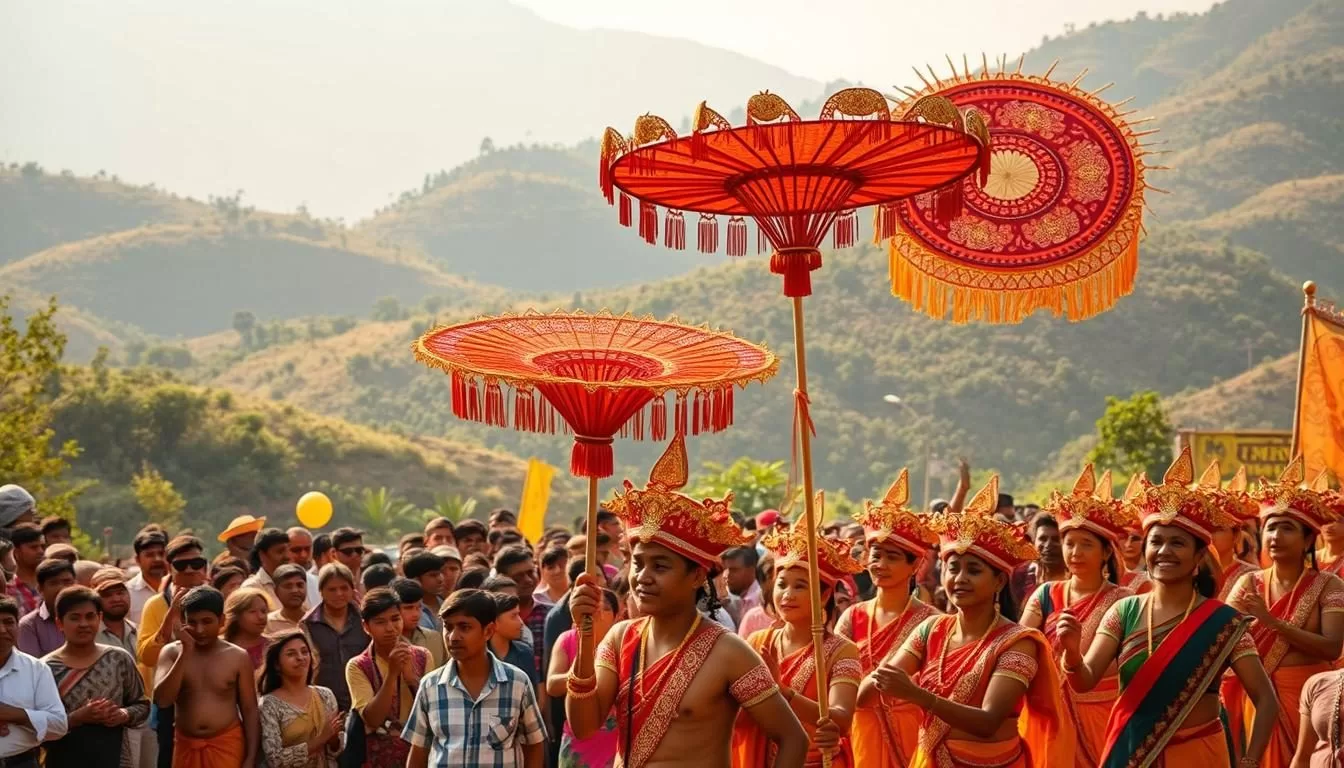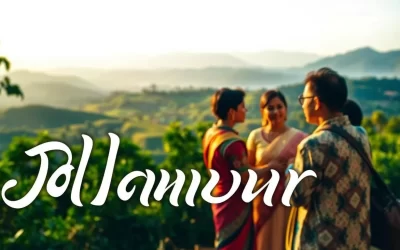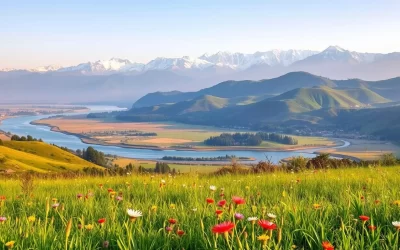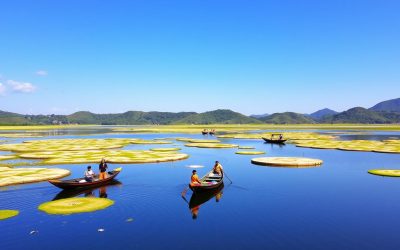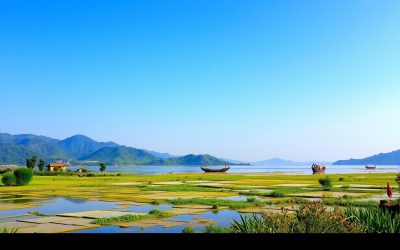✓ Accommodations✓ Flights✓ Rental Cars
Are you ready to experience the vibrant culture and traditions of Manipur? Known as ‘The Jewel of North East India’, Manipur offers a rich tapestry of cultural celebrations throughout the year. Its festivals showcase the region’s unique heritage, reflecting the diverse art forms and spirit of the Manipuri people.
These celebrations are not just cultural displays but living traditions that continue to evolve while maintaining their historical significance and spiritual importance. By timing your visit to coincide with one of these festivals, you can transform your travel experience, gaining deeper insights into local customs and creating unforgettable memories.
The Cultural Richness of Manipur
As you explore Manipur, you’ll discover a land steeped in cultural richness, where festivals play a significant role in everyday life. The state’s unique cultural identity is reflected in its diverse festivals and traditions.
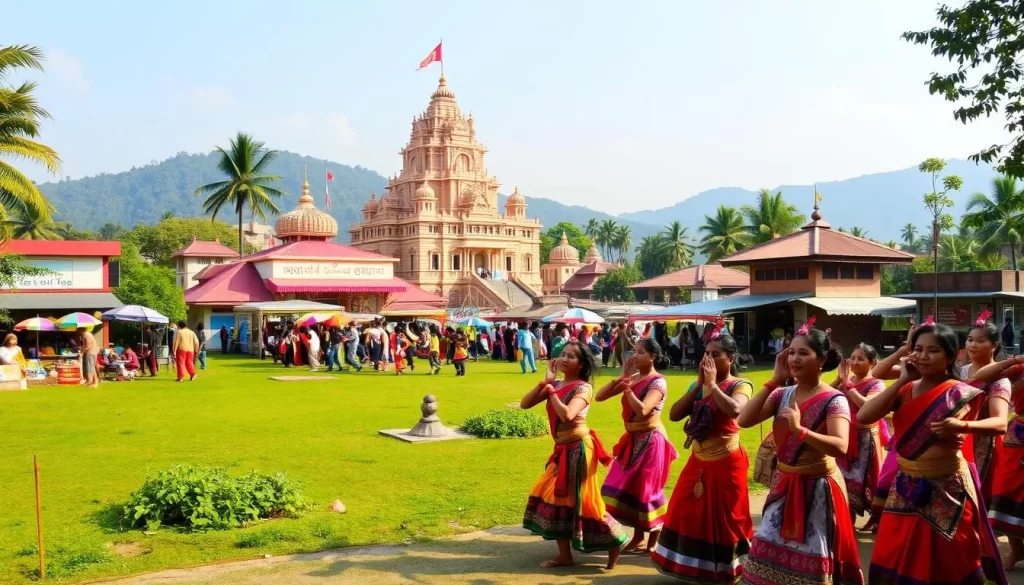
The Jewel of Northeast India
Manipur is often referred to as the “Jewel of Northeast India” due to its rich culture and natural beauty. The state’s festivals are a testament to its vibrant cultural heritage.
Significance of Festivals in Manipuri Culture
Festivals in Manipur serve as vital cultural anchors, preserving ancient traditions and strengthening community bonds. They are deeply intertwined with agricultural cycles, marking seasonal transitions and celebrating the relationship between people and nature.
Yaoshang: Manipur’s Vibrant Holi Celebration
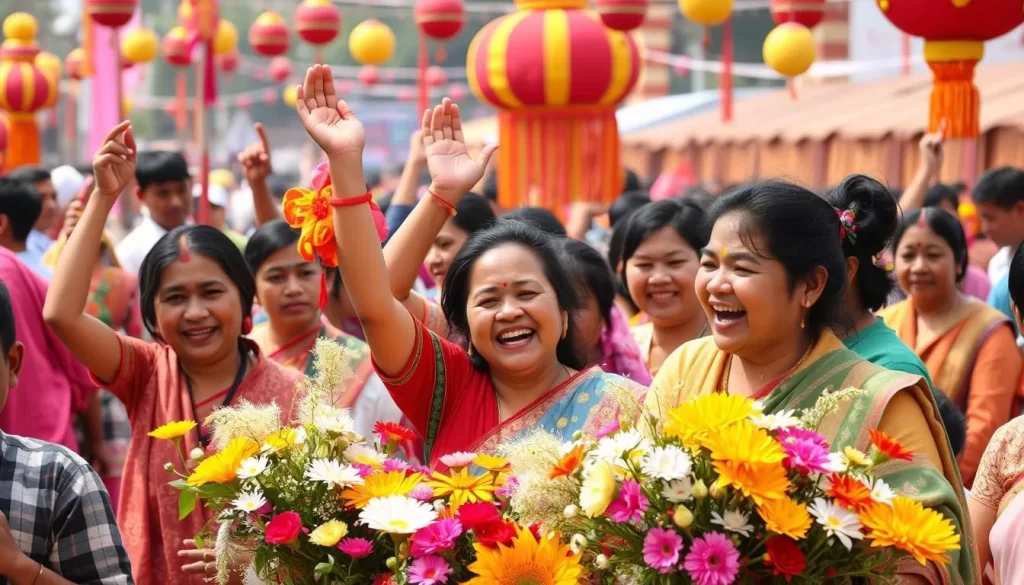
Manipur’s version of Holi, Yaoshang, is a unique and vibrant celebration that showcases the state’s rich cultural heritage. You can experience the joy and enthusiasm of the locals as they come together to celebrate this significant festival.
Five Days of Color and Joy
Yaoshang is a five-day celebration that is filled with colors, music, and dance. You can expect to see people playing with colors, singing traditional songs, and performing folk dance. The atmosphere is electric, and you can’t help but be swept up in the excitement.
Thabal Chongba: The Moonlight Dance
The name ‘Thabal Chongba’ means ‘Moonlight Dance’, which is done at night. You can witness this traditional dance, where young men and women dance together under the moonlight, creating a magical atmosphere. The dance is a significant part of the Yaoshang celebration, and you can experience the romance and joy that it embodies.
Kang Chingba: Manipur’s Grand Rath Yatra
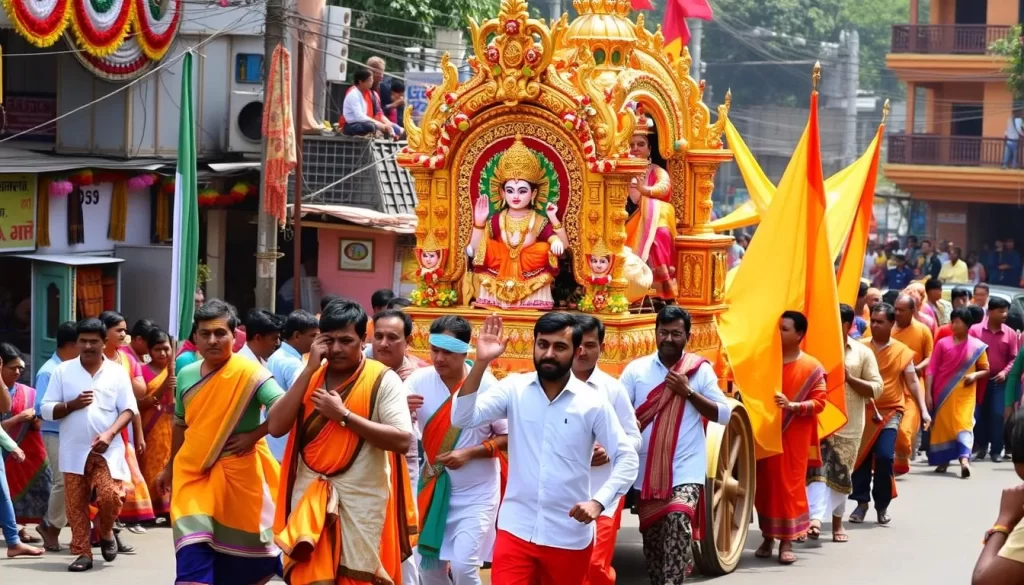
The Kang Chingba festival, also known as Manipur’s Rath Yatra, is a celebration of devotion and community spirit. This significant event is observed with great fervor, primarily at the Shree Govindajee Temple in Imphal.
The festival is a tribute to Lord Jagannath, with the Rath Yatra being a crucial part of the celebrations. Thousands of worshippers pull the Rath throughout the journey, drawn by its enormous height and wonderfully decorated appearance.
Devotion to Lord Jagannath
The Kang Chingba procession takes place with great pomp and ceremony, mainly on the first and last days of the eight-day festival period. This creates a powerful display of collective devotion and community spirit as thousands of devotees gather to pull the massive chariot carrying Lord Jagannath.
Procession and Celebrations
The chariots are meticulously decorated with colorful fabrics, flowers, and traditional Manipuri art, making them stunning visual centerpieces of the celebration. Along the procession route, devotees offer prayers, sing devotional songs, and perform traditional dances to honor Lord Jagannath.
While the main celebrations take place at the Shree Govindajee Temple, smaller versions of the festival occur in various Vaishnav temples throughout Manipur, allowing visitors to experience the celebration in different settings.
Ningol Chakouba: Celebrating Family Bonds

Manipur’s Ningol Chakouba is a unique celebration that brings families together, strengthening the bond between parents and daughters. It’s a day when married daughters visit their parental homes, accompanied by their children, to spend quality time with their families.
Honoring Married Daughters
The essence of Ningol Chakouba lies in honoring married daughters, who are welcomed back to their parental homes with open arms. The celebration is marked by love, respect, and the strengthening of family ties.
Feast and Gift Exchange Traditions
The festival is characterized by an elaborate feast prepared by mothers for their daughters, featuring traditional Manipuri delicacies. The day also includes a reciprocal gift exchange between parents and daughters, symbolizing love and blessings.
Ningol Chakouba is not just a family celebration; it has evolved to include community events that foster social harmony and cross-cultural understanding among the people of Manipur, making it a significant event in the region.
Cheiraoba: Manipuri New Year Celebrations
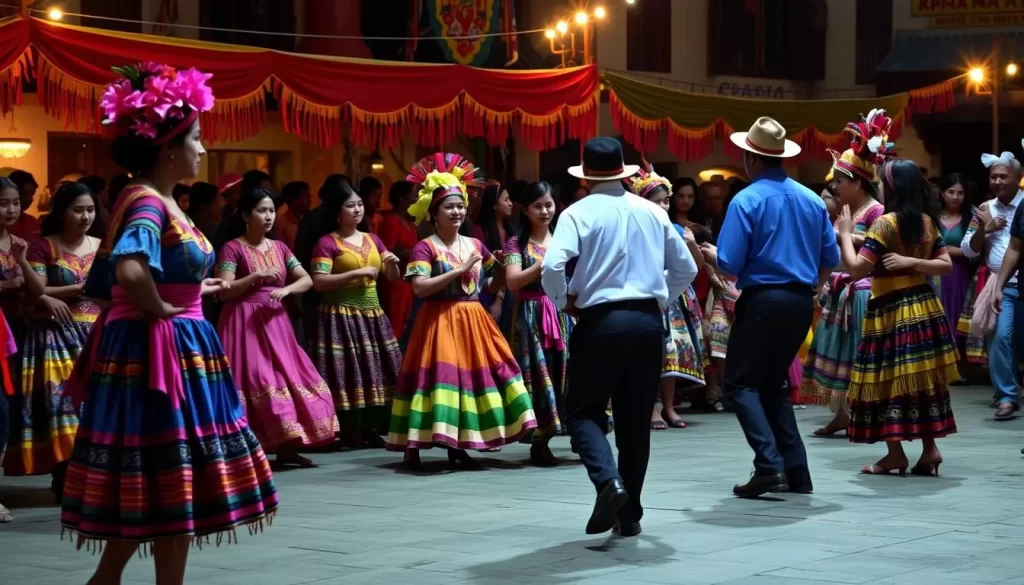
Cheiraoba is more than just a festival; it’s the Manipuri New Year celebration that embodies the spirit of renewal and togetherness. As you experience this vibrant festival, you’ll be immersed in a rich tapestry of traditions and cultural practices that are unique to Manipur.
Rituals and Traditions
The celebration is marked by people dressing up in traditional costumes, worshiping the local goddess, and exchanging gifts among family and friends. This festival is a beautiful representation of the strong bond of affection amongst family members, and it’s interesting to note that Cheiraoba is celebrated not just by Hindus but also by the state’s Muslims, showcasing the communal harmony of Manipur.
Hill Climbing and Family Gatherings
A distinctive tradition of Cheiraoba involves an afternoon hill climbing activity where families ascend nearby hills or high places. This act symbolizes progress and elevation in life during the coming year. From these elevated vantage points, people offer prayers to the gods and ancestors, creating a meaningful connection between the natural landscape and spiritual practices.
The hill climbing is followed by family gatherings where elders share stories and wisdom with younger generations, helping preserve oral traditions and family histories. You can expect to see people dressed in their finest traditional attire, with women wearing the elegant phanek and innaphi, and men donning the dhoti and kurta. The evening features cultural performances, including traditional music and dance, creating a festive atmosphere that brings communities together.
Kut Festival: Harvest Celebration of Tribal Communities

You can experience the rich cultural heritage of Manipur’s tribal communities during the Kut Festival. This vibrant celebration is a significant event for the tribal communities, marking the end of the harvest season.
The Kut Festival is a time for farmers to gather their entire harvest and celebrate the achievement of a healthy crop. It’s a period of joy and gratitude, reflecting the community’s dependence on agriculture.
The Autumn Harvest
The Kut Festival, also known as Chavang Kut, is celebrated during the autumn season. It is a time when the crops are harvested, and the community comes together to rejoice. Traditional dances like Lamjang, Laam, and Khurpui Laam are performed, showcasing the rich cultural heritage of the tribal communities.
Cultural Performances and Community Feasting
The festival features spectacular cultural performances, including traditional music played on instruments like the pheiphit (drum), theile (flute), and goshem (gong). The community feast is a central element of Kut, where traditional delicacies made from the newly harvested crops are shared, symbolizing abundance and community sharing.
The Kut Festival includes various competitions such as traditional wrestling, bamboo climbing, and beauty pageants, highlighting different aspects of tribal culture and skills. Modern Kut celebrations often feature fashion shows displaying traditional attire with contemporary adaptations, demonstrating how the festival continues to evolve while preserving cultural heritage.
As you participate in or observe the Kut Festival, you will be immersed in the vibrant culture and traditions of Manipur’s tribal communities. The festival is a celebration of the harvest, community bonding, and the rich cultural heritage of the region.
Heikru Hidongba: The Sacred Boat Race
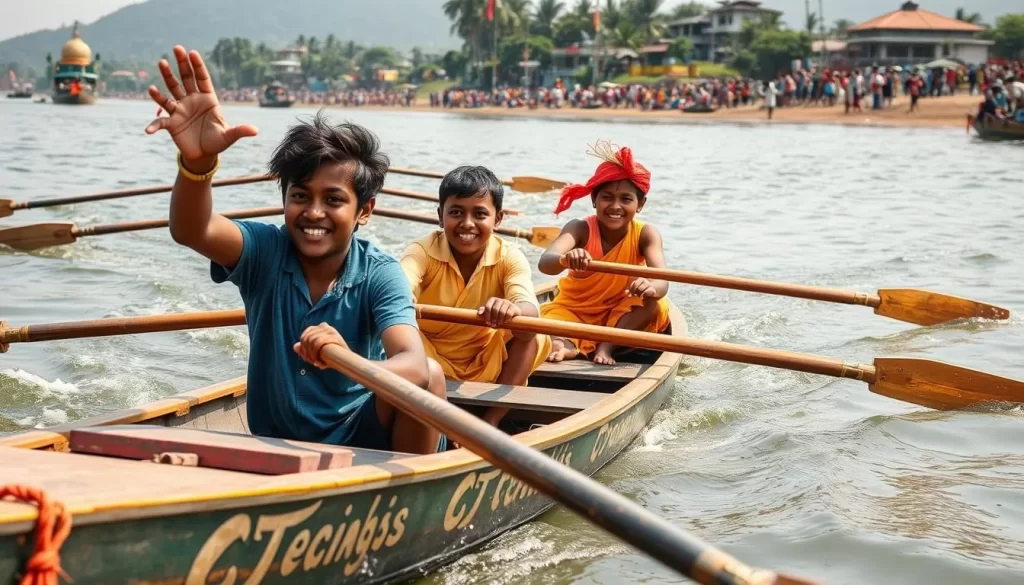
Experience the thrill of Heikru Hidongba, Manipur’s sacred boat race that embodies the state’s rich cultural heritage. This exciting festival features teams of skilled young rowers competing in specially designed canoe-like boats.
Religious Significance
The night before the celebration, the boats undergo purification rituals where they are cleansed, blessed with sacred mantras, and decorated with flowers. This sacred ritual prepares the boats for the competition, highlighting the deep religious significance of the event.
The Competitive Spirit
The Heikru Hidongba boat race takes place on a specific day in Manipur’s Bijoy Govinda region. On this day, temporary viewing pavilions are erected for spectators who gather from across the state. The race fosters a sense of community and friendly rivalry among different villages or communities, making it a significant place for social gatherings and cultural exchange. The event brings together parts of the community, strengthening inter-community bonds.
Gang Ngai: The Winter Festival of Kabui Nagas
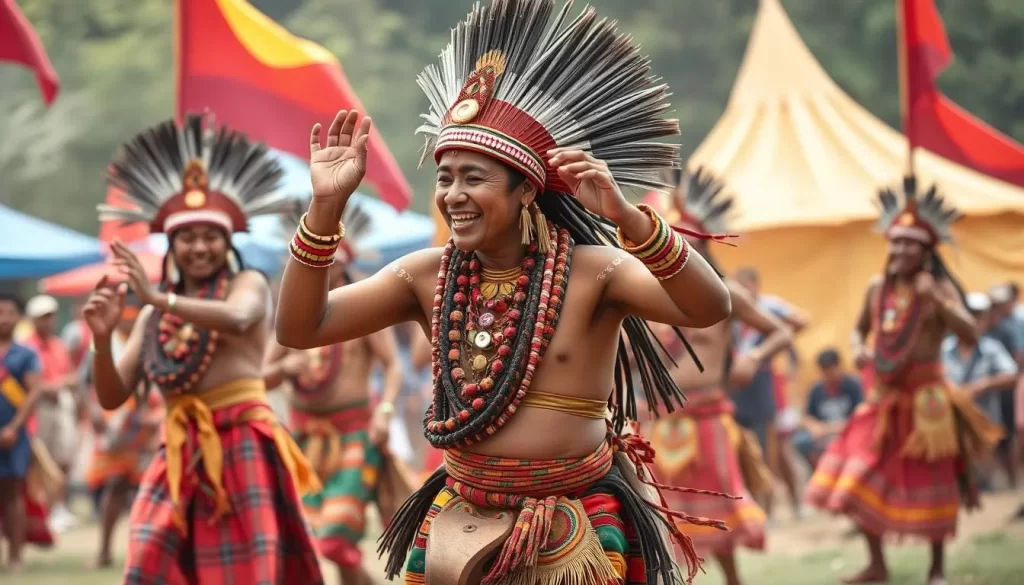
You can experience the vibrant culture of the Kabui Naga tribe during Gang Ngai, a five-day winter festival in Manipur. This significant cultural event is observed with great fervor, showcasing the community’s rich heritage through various ceremonies and performances.
Five Days of Spiritual Ceremonies
The Gang Ngai celebration spans five days, each filled with spiritual ceremonies and traditional rituals. These ceremonies are crucial to the Kabui Naga community, as they bring together the people and strengthen their bond with their heritage.
Traditional music played on indigenous instruments like the khong (drum), pena (string instrument), and sareng (flute) creates the rhythmic backdrop for Gang Ngai celebrations. The community comes together to perform dance forms that are unique to their culture, often mimicking natural elements or telling stories of tribal history and mythology.
Traditional Music and Dance Performances
The festival features distinctive dance forms performed by men and women in traditional attire. The music is an integral part of the celebration, with young people learning these traditional performances from elders, ensuring cultural continuity.
Evening performances around community bonfires create a magical atmosphere where stories are shared through song and dance, strengthening community bonds. The final day of Gang Ngai culminates in the grandest performances, showcasing the artistic talents of the community.
Lai Haraoba: Pleasing the Sylvan Deities

Lai Haraoba, meaning ‘pleasing the gods,’ is a traditional Manipuri festival rich in rituals and dance. This festival is a celebration of life and the connection between the community and nature.
Ancient Rituals and Ceremonies
The Lai Haraoba celebration is characterized by ancient rituals and ceremonies that have been passed down through generations. These rituals are significant to the Manipuri people, as they are believed to appease the deities and ensure the well-being of the community.
The Maibis and Their Sacred Dances
The Maibis, or female priestesses, play a central role in the Lai Haraoba festival. They perform sacred dances that narrate the story of creation, with each movement having symbolic meaning related to cosmic events and natural processes. The dance performances are accompanied by traditional music, creating a mesmerizing experience.
Sangai Festival: Showcasing Manipur’s Cultural Heritage
Manipur’s cultural identity is on full display during the Sangai Festival, a celebration like no other. This annual event is a testament to the state’s rich cultural diversity and its people’s enthusiasm for preserving their heritage.
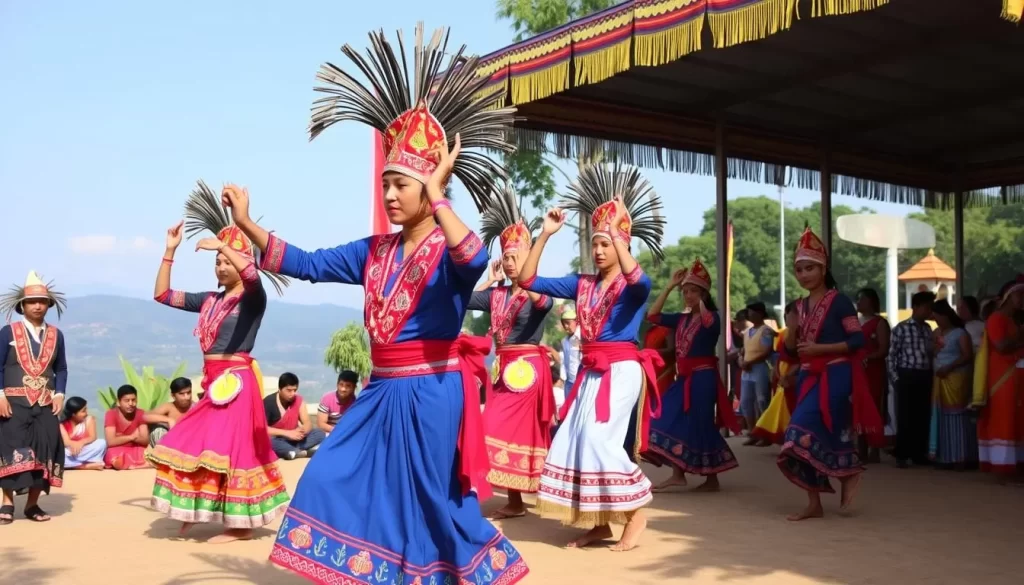
Celebrating the State Animal
The Sangai Festival is named after the Sangai deer, Manipur’s state animal, which is found only in the Keibul Lamjao National Park. The festival celebrates this unique biodiversity and the cultural significance of the Sangai deer in Manipuri culture.
Cultural Exhibitions and Performances
The festival features a wide range of cultural exhibitions and performances, including classical Manipuri dance, indigenous tribal dances, martial arts demonstrations, and contemporary artistic expressions. You can also explore exhibition pavilions showcasing Manipur’s traditional handicrafts, handloom products, and indigenous food items, giving you a comprehensive view of the state’s material culture.
Manipur, India: Top Festivals to Check Out When Visiting Throughout the Year
As you plan your visit to Manipur, make sure to check out the various festivals that take place throughout the year, each offering a unique glimpse into the state’s rich cultural heritage. Manipur’s festivals are a reflection of its diverse cultural identity, with different communities coming together to celebrate their traditions.
Festival Calendar: When to Visit
Manipur’s festival calendar is filled with events that take place throughout the year. You can plan your visit according to the festival you’re interested in attending. Here’s a brief overview of the festivals and their timing:
| Season | Festivals | Month |
|---|---|---|
| Winter | Gang Ngai | January |
| Spring | Yaoshang, Cheiraoba | March-April |
| Summer | Kang Chingba, Heikru Hidongba | June-July |
| Autumn | Kut Festival, Lai Haraoba | September-October |
Seasonal Highlights
Each season in Manipur offers a unique festival experience. You can witness community gatherings and spiritual renewal during winter, renewal and purification during spring, water-based celebrations during summer, and harvest festivals during autumn. The state’s festivals are a great way to experience its rich cultural heritage.
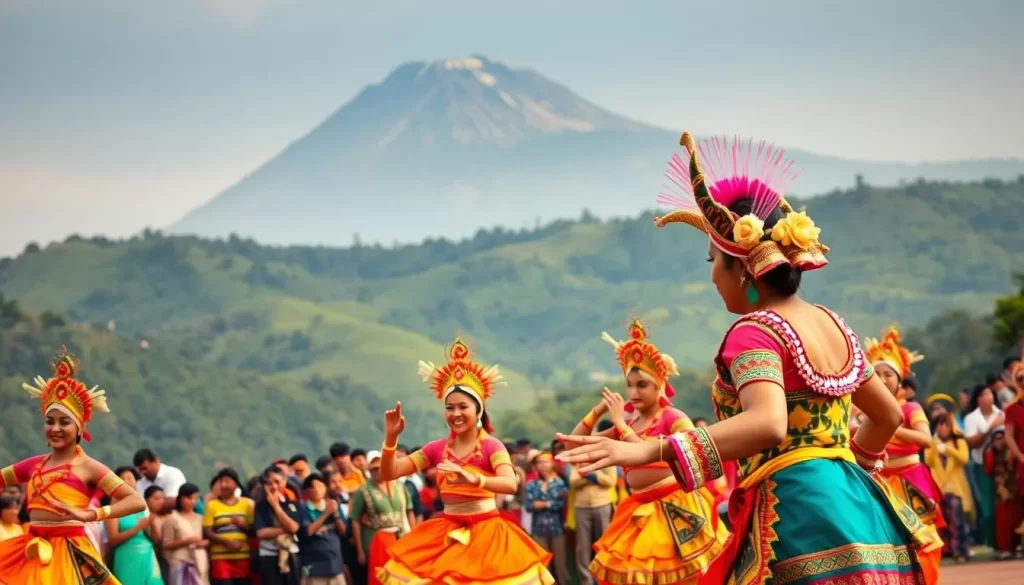
What to Expect at Manipuri Festivals
You’ll experience the warmth of Manipuri culture through its festivals. The state’s festivals are a vibrant representation of its rich cultural heritage, showcasing traditional attire, music, and dance. As you participate in or attend these festivals, you’ll be treated to a unique cultural experience that highlights the diversity and vibrancy of Manipur.
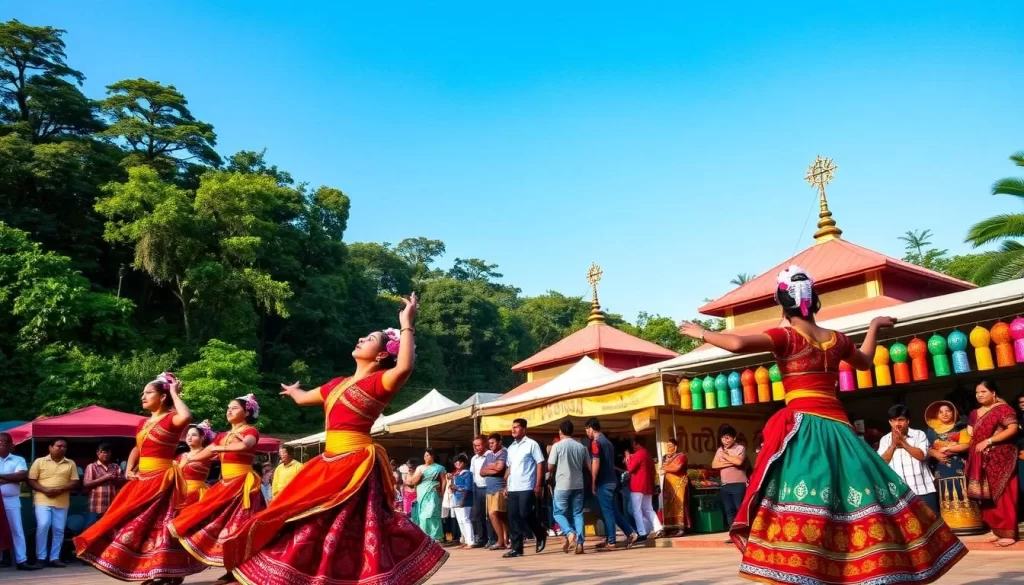
Traditional Attire and Ornaments
During Manipuri festivals, traditional attire and ornaments play a significant role. The intricate designs and craftsmanship of Manipuri clothing are on full display, with women adorning traditional dresses and men wearing elegant ornaments. The traditional attire is often complemented by exquisite jewelry, adding to the overall splendor of the festivals.
Music, Dance, and Performances
Manipuri festivals are characterized by their rich musical and dance heritage. You can expect to witness Manipuri classical dance, one of India’s eight classical dance forms, with its graceful movements and spiritual themes. The festivals also feature traditional musical instruments like the pung, pena, and sembung, creating a distinctive soundscape. Various tribal communities showcase their unique dance forms, and theatrical performances like Shumang Leela and Lai Haraoba rituals combine elements of dance, music, and storytelling.
Local Cuisine During Festival Seasons
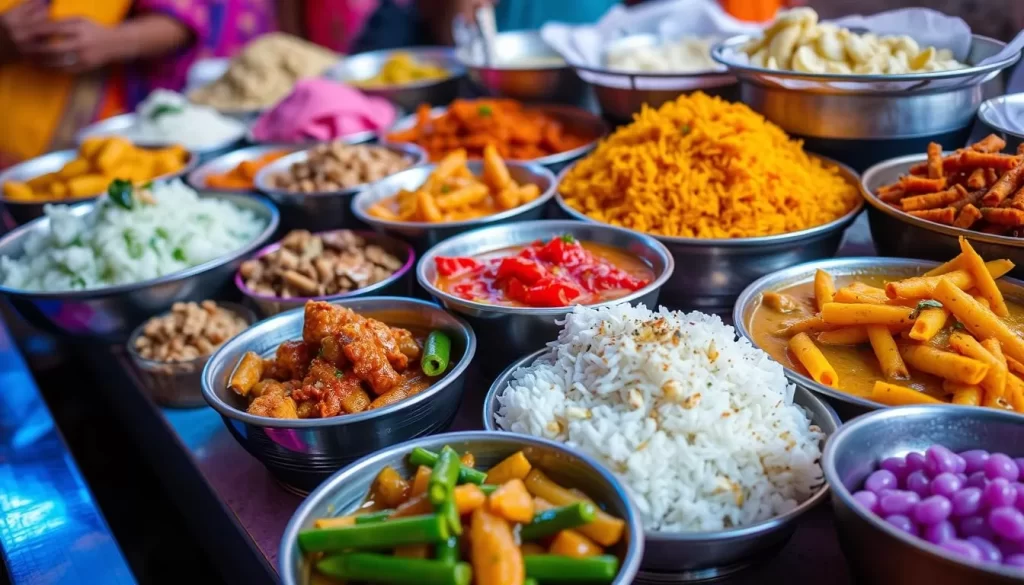
The local cuisine during Manipuri festivals is a reflection of the state’s rich culinary traditions and cultural diversity. As you participate in these vibrant celebrations, you’ll discover the rich flavors and traditional delicacies that are an integral part of Manipur’s culture.
Manipuri festivals are characterized by elaborate feasts that bring together communities and showcase the state’s culinary heritage. The cuisine is simple yet flavorful, with a focus on locally sourced ingredients and traditional cooking methods.
Traditional Delicacies
Some of the staple festival dishes include Chamthong (vegetable stew), ooti (bamboo shoot with lentils), and kangshoi (vegetables cooked with minimal spices). These dishes not only delight the palate but also hold symbolic significance, connecting the community to their cultural heritage.
Ceremonial Dishes and Beverages
Traditional beverages like zutho (rice beer) and atingba (distilled liquor) play important roles in tribal festival celebrations. Sweets and desserts, such as cham-cham (rice flour dumplings in sweet syrup) and tan (palm jaggery dessert), are also prepared specially for these occasions, adding to the festive atmosphere.
How to Participate as a Visitor
When attending Manipur’s festivals, being mindful of the local etiquette can make a significant difference in your experience. As a visitor, you have the opportunity to engage with the local culture and people in a meaningful way.
Etiquette and Cultural Sensitivity
To participate respectfully, it’s essential to understand the local customs and traditions. Be aware of your surroundings and avoid disrupting the proceedings. Dress modestly and follow the lead of the local people in terms of attire and behavior.
Photography and Interaction Tips
When it comes to capturing memories, consider the following tips: Bring a camera with good low-light capabilities, as many ceremonies take place during dawn, dusk, or in dimly lit settings. Position yourself respectfully at the periphery of ceremonies. Engage with visitors and participants through genuine interest and respectful questions.
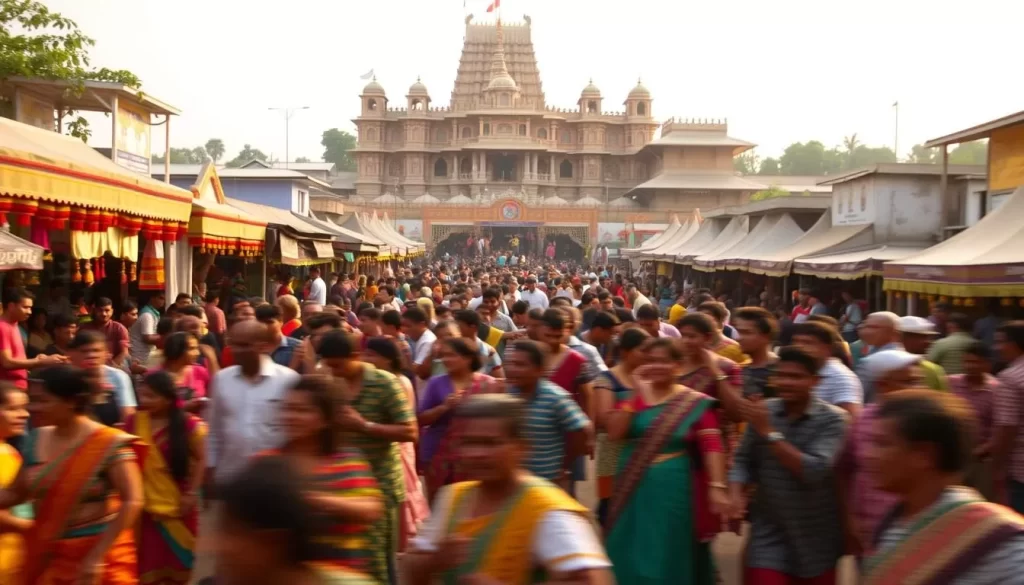
| Tips for Visitors | Description |
|---|---|
| Be Respectful | Position yourself at the periphery of ceremonies and avoid disrupting the proceedings. |
| Engage with Locals | Show genuine interest and ask respectful questions to foster meaningful cultural exchanges. |
| Consider a Local Guide | Hiring a local guide can help explain the significance of festival elements and navigate appropriate behavior. |
Planning Your Trip Around Manipur’s Festivals
To experience the rich cultural heritage of Manipur, timing your visit around its festivals is crucial. Manipur’s festivals are a window into the soul of this beautiful state, showcasing its vibrant traditions and cultural richness.

When planning your trip, consider the various festivals that take place throughout the year. Each festival offers a unique glimpse into the state’s cultural fabric.
Accommodation and Transportation
As you plan your visit to Manipur during its festivals, it’s essential to book your accommodation and transportation in advance. The state’s infrastructure is geared to support tourists during these times, with various options ranging from budget-friendly guesthouses to luxury hotels.
For transportation, you can choose between local taxis, rental cars, or public transport, depending on your preference and budget. Several tour operators also offer packages that include transportation, making it easier to get around.
Local Guides and Tour Options
Hiring a knowledgeable local guide can significantly enhance your experience when attending Manipuri festivals. They provide cultural context, translate proceedings, and ensure you don’t miss key events.
- Hiring a knowledgeable local guide is invaluable when attending Manipuri festivals, as they can provide cultural context, translate proceedings, and ensure you don’t miss key events.
- Several tour operators in Imphal specialize in festival tourism, offering packages that include transportation, accommodation, and guided experiences at major celebrations.
- Consider combining festival attendance with visits to related cultural sites, such as temples associated with religious festivals or natural areas connected to harvest celebrations.
- Community-based tourism initiatives in Manipur often provide authentic festival experiences while ensuring tourism benefits local communities directly.
- For those interested in photography or specific cultural aspects, specialized tours focusing on performing arts, textiles, or culinary traditions during festivals can provide deeper insights into particular elements of Manipuri culture.
Conclusion
With its numerous festivals, Manipur provides an immersive cultural experience like no other. By timing your visit to coincide with one or more of these celebrations, you’ll witness the state’s rich cultural tapestry, where ancient traditions continue to thrive alongside evolving contemporary expressions.
Each festival offers a unique insight into different aspects of Manipuri life, from religious beliefs and agricultural practices to family bonds and artistic expressions. You’ll experience Manipur at its most authentic and joyous, deepening your appreciation for this jewel of Northeast India.
Whether you’re drawn to the colorful celebrations of Yaoshang or the devotional fervor of Kang Chingba, Manipur’s festival calendar promises unforgettable experiences that showcase the state’s vibrant culture and traditions.
The above is subject to change.
Check back often to TRAVEL.COM for the latest travel tips and deals.
